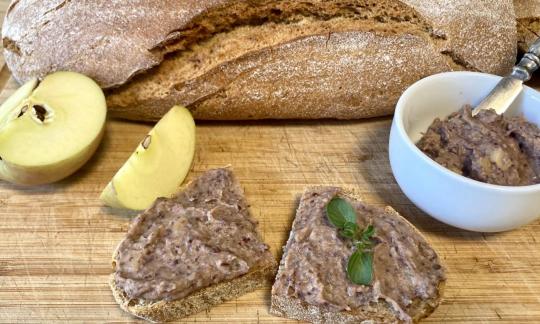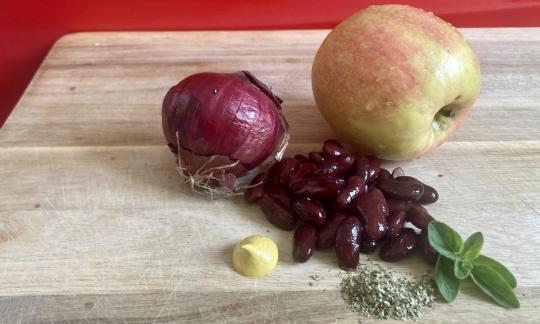Vegan, low-calorie "liver sausage" spread
vegan
Ingredients (for servings, )
| For the "liver sausage" spread | |
|---|---|
| 2 ½ oz | Onions, red, raw |
| 2 ⅛ oz | Apples, raw, without peel (organic?) |
| 4 ⅓ oz | Kidney beans, cooked, without salt (organic?) |
| 1 tsp | Mustard (Mostert, Mostrich, raw?, organic?) (0.18 oz) |
| 1 ½ tsp | Marjoram, dried (raw?, organic?) (0.03 oz) |
Equipment
- hand-held blender / immersion blender
- vegetable peeler
- skillet (frying pan)
- stove
- sieve
Type of preparation
- chop or grind
- sweat
- season to taste
- sauté
- purée
- remove the skin
- peel
- drain
Preparation
Prepare ingredients
Peel the onion and dice finely. Wash and peel the apple and dice half finely. Set the other half aside.For 4 servings you need 70 g of onion, which is about half a medium-sized onion.
Put the finely diced apple and onions in a pan. Add a little water or optionally refined rapeseed oil. Sauté for about 3 minutes while stirring.
Place cooked kidney beans in a sieve, rinse and drain. Puree together with the second half of the apple using a hand blender/mixer.
If you want to use dried kidney beans, soak them the day before. Pour off the soaking water, rinse the beans under running water and cook them in fresh water for at least 45 minutes or until cooked (in a pressure cooker, it will take about 25 minutes).
Finishing the spread
Add the onion and apple mixture to the bean puree and mix with medium-hot mustard and dried marjoram. Season to taste with mustard, marjoram and a little salt if necessary and serve as a spread on homemade wholemeal bread, for example.Recipes for homemade bread can be found under Tips.
|
Nutritional Information per person
Convert per 100g
|
2000 kcal | |
|---|---|---|
| Energy | 54 kcal | 2.7% |
| Fat/Lipids | 0.24 g | 0.4% |
| Saturated Fats | 0.04 g | 0.2% |
| Carbohydrates (inc.dietary fiber) | 11 g | 3.9% |
| Sugars | 2.4 g | 2.6% |
| Fiber | 2.6 g | 10.2% |
| Protein/Albumin | 2.9 g | 5.8% |
| Cooking Salt (Na:15.0 mg) | 38 mg | 1.6% |
| Essential micronutrients with the highest proportions | per person | 2000 kcal | |
|---|---|---|---|
| Vit | Vitamin B9, B11 (Folate, as the active form of folic acid) | 43 µg | 22.0% |
| Prot | Tryptophan (Trp, W) | 0.03 g | 14.0% |
| Prot | Threonine (Thr, T, irreversibly transaminated) | 0.10 g | 11.0% |
| Prot | Isoleucine (Ile, I) | 0.13 g | 10.0% |
| Prot | Leucine (Leu, L) | 0.23 g | 10.0% |
| Prot | Lysine (Lys, K, irreversibly transaminated) | 0.19 g | 10.0% |
| Prot | Phenylalanine (Phe, F) | 0.16 g | 10.0% |
| Prot | Valin (Val, V) | 0.16 g | 10.0% |
| Min | Manganese, Mn | 0.18 mg | 9.0% |
| Elem | Potassium, K | 166 mg | 8.0% |
Detailed Nutritional Information per Person for this Recipe
The majority of the nutritional information comes from the USDA (US Department of Agriculture). This means that the information for natural products is often incomplete or only given within broader categories, whereas in most cases products made from these have more complete information displayed.
If we take flaxseed, for example, the important essential amino acid ALA (omega-3) is only included in an overarching category whereas for flaxseed oil ALA is listed specifically. In time, we will be able to change this, but it will require a lot of work. An “i” appears behind ingredients that have been adjusted and an explanation appears when you hover over this symbol.
For Erb Muesli, the original calculations resulted in 48 % of the daily requirement of ALA — but with the correction, we see that the muesli actually covers >100 % of the necessary recommendation for the omega-3 fatty acid ALA. Our goal is to eventually be able to compare the nutritional value of our recipes with those that are used in conventional western lifestyles.
| Essential fatty acids | per person | 2000 kcal |
|---|---|---|
| Alpha-Linolenic acid; ALA; 18:3 omega-3 | 0.06 g | 3.0% |
| Linoleic acid; LA; 18:2 omega-6 | 0.05 g | < 0.1% |
| Essential amino acids | per person | 2000 kcal |
|---|---|---|
| Tryptophan (Trp, W) | 0.03 g | 14.0% |
| Threonine (Thr, T, irreversibly transaminated) | 0.10 g | 11.0% |
| Isoleucine (Ile, I) | 0.13 g | 10.0% |
| Leucine (Leu, L) | 0.23 g | 10.0% |
| Lysine (Lys, K, irreversibly transaminated) | 0.19 g | 10.0% |
| Phenylalanine (Phe, F) | 0.16 g | 10.0% |
| Valin (Val, V) | 0.16 g | 10.0% |
| Methionine (Met, M) | 0.04 g | 4.0% |
| Vitamins | per person | 2000 kcal |
|---|---|---|
| Vitamin B9, B11 (Folate, as the active form of folic acid) | 43 µg | 22.0% |
| Vitamin B1 (Thiamine) | 0.06 mg | 6.0% |
| Vitamin B6 (pyridoxine) | 0.07 mg | 5.0% |
| Vitamin K | 4.1 µg | 5.0% |
| Vitamin C (ascorbic acid) | 2.4 mg | 3.0% |
| Vitamin B2 (Riboflavin) | 0.03 mg | 2.0% |
| Vitamin B5 (Pantothenic acid) | 0.10 mg | 2.0% |
| Vitamin B3 (Niacin) | 0.22 mg | 1.0% |
| Vitamin B7 (Biotin, ex vitamin H) | 0.70 µg | 1.0% |
| Vitamin A, as RAE | 1.3 µg | < 0.1% |
| Vitamin E, as a-TEs | 0.03 mg | < 0.1% |
| Essential macroelements (macronutrients) | per person | 2000 kcal |
|---|---|---|
| Potassium, K | 166 mg | 8.0% |
| Phosphorus, P | 50 mg | 7.0% |
| Magnesium, Mg | 16 mg | 4.0% |
| Calcium, Ca | 21 mg | 3.0% |
| Sodium, Na | 15 mg | 2.0% |
| Essential trace elements (micronutrients) | per person | 2000 kcal |
|---|---|---|
| Manganese, Mn | 0.18 mg | 9.0% |
| Copper, Cu | 0.08 mg | 8.0% |
| Iron, Fe | 0.92 mg | 7.0% |
| Zinc, Zn | 0.35 mg | 4.0% |
| Selenium, Se | 0.85 µg | 2.0% |
| Fluorine, F | 0.21 µg | < 0.1% |
| Iod, I (Jod, J) | 0.32 µg | < 0.1% |
Quick vegan, low-calorie "liver sausage" spread with kidney beans, onion, apple and marjoram.
Quantity: The stated quantity of 4 portions is sufficient as a generous spread on its own, for example for dinner for 4 people.
Nutrient profile: According to GDA guidelines, one portion of this low-calorie spread covers about a fifth of the average daily requirement of folic acid. It also contains around 10% of the daily requirement of seven of the eight amino acids essential for humans.
Kidney beans: As kidney beans is the name given to the large, red seeds of the common bean. The bean owes its name to its kidney-like shape. Kidney beans have a very high protein content and are rich in vitamins and minerals. Dried kidney beans will last a very long time if stored dry and airtight. Canned kidney beans have an almost unlimited shelf life. If possible, you should use natural canned beans, i.e. without salt or other additives. Information on dried kidney beans can be found in this recipe under "Alternative preparation".
Marjoram: Marjoram, also known as sausage herb, is popular because of its strong flavor. It goes well with legumes and Mediterranean dishes. Marjoram has a high proportion of essential oils, which give the plant a strong and distinctive flavor. Thanks to its strong flavor, marjoram should be used sparingly. However, marjoram tastes a little milder than its relative, oregano.
Mustard: Mustard is made by mixing mustard seeds with water, vinegar and salt to make a yellow paste. Mustard seeds contain a high proportion of mustard oil and the glycosides sinalbin and sinigrin, which are responsible for the spicy taste and therefore also for the appetite-stimulating and digestive effects. We used medium to hot mustard in this recipe.
The spread is perfect for homemade wholegrain bread. See some recipe suggestions :
Dried beans, advantages and preparation: In the trade, kidney beans (like other beans and legumes) are usually dried or pre-cooked and preserved. While the canned version is of course more convenient and time-saving, the dried version has the advantage of better flavor. Additionally, canned foods often have unnecessary additives or are already salted, so the unprocessed version is always preferable if you can plan ahead. If you are using dried kidney beans, soak them the day before. Pour off the soaking water, rinse the beans under running water and cook them in fresh water for at least 45 minutes or until cooked (in a pressure cooker, it will take about 25 minutes).






